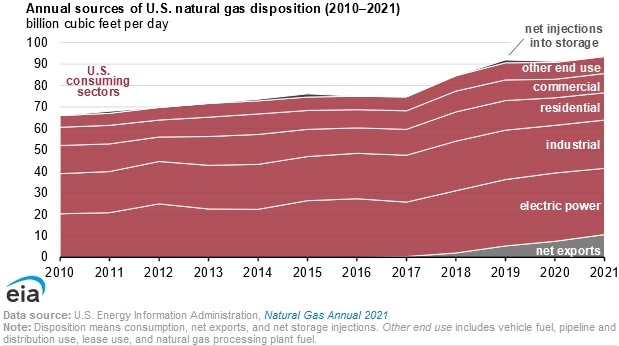U.S. Gas Disposition Higher During 2021, Driven by LNG Exports: EIA

Net disposition of gas in the U.S. increased by 3.6 percent year-on-year in 2021, in line with growth in liquified natural gas, or LNG exports, according to a Nov. 15 report from the U.S. Energy Information Administration. The agency defines net disposition as consumption, net exports, and net storage.
U.S. gas exports have been a key driver of gas disposition and reached a new high in 2021, averaging 10.5 billion cubic feet per day (bcf/d). Exports have increased due to record LNG shipments to both Asia and Europe. The Russian invasion of Ukraine has led to reduced Russian gas supplies into Europe. In order to lessen the commodity price impact on households and businesses, Europe has increased LNG trade with the U.S. and has imported record levels of U.S. LNG to ensure storage sites are sufficiently filled to get through the upcoming winter period (October 2022 – March 2023). During the first six months of 2022, U.S. LNG exports continued to increase, and the EIA in their Short Term Energy Outlook project continuous growth in LNG exports up until 2023, due to expectations that Europe will continue to rely on U.S. gas to meet domestic demand.
U.S. gas consumption during 2021, declined in both the electric and residential sectors compared to 2020 and in all major U.S. end use sectors compared to 2019. U.S. gas consumption in the electricity sector was 2.7 percent lower in 2021, than in 2020 and 0.2 percent less than in 2019. The decline can be attributed to weather, as in 2021 cooling demand in buildings declined below 2020 and 2019, in line with below seasonal normal temperatures during the summer. Moreover, the EIA projects gas consumption in the electricity sector to decline in 2023, compared to 2022.
In contrast, consumption in the industrial sector, the second highest consumer of gas in the U.S. increased by 0.8 percent in 2021, compared to 2020. The increase can be attributed to an uptick in activity, following COVID-19 related lockdown restrictions during the majority of 2020. Residential gas consumption in the U.S. has been largely stable over the last 10 years.
EnerKnol Pulses like this one are powered by the EnerKnol Platform—the first comprehensive database for real-time energy policy tracking. Sign up for a free trial below for access to key regulatory data and deep industry insights across the energy spectrum.
ACCESS FREE TRIAL